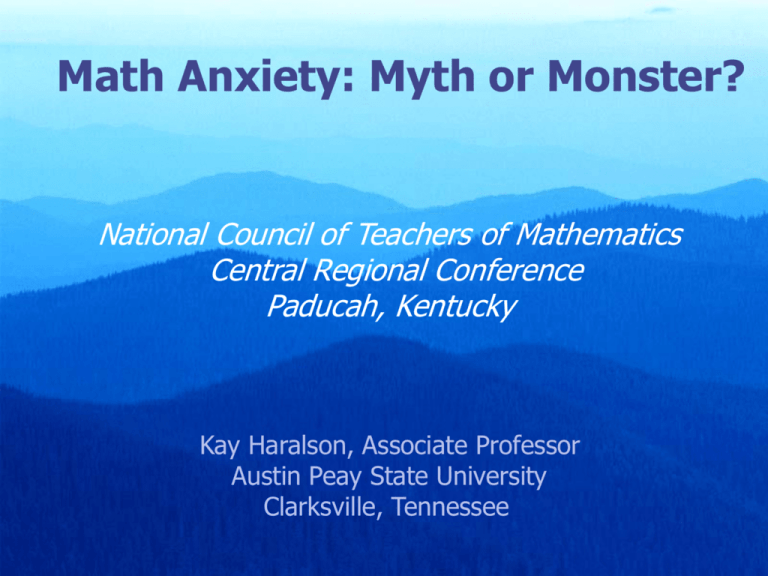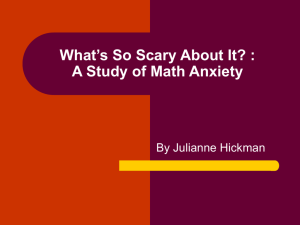Creative Strategies for Diffusing Math Anxiety
advertisement

Math Anxiety: Myth or Monster? National Council of Teachers of Mathematics 79th Annual Conference Orlando, Florida National Council of Teachers of Mathematics Central Regional Conference Paducah, Kentucky Math World: New Standards for the New Millennium Kay Haralson, Associate Professor Austin Peay State University Clarksville, Tennessee State supported liberal arts institution Clarksville, Tennessee Approximate enrollment of 6500 students Approximately 50% of the student body is greater than 24 years of age. Definition of Math Anxiety “Tobias and Weissbrod (1980) defined math anxiety as the panic, helplessness, paralysis, and mental disorganization that arises among some people when they are required to solve a mathematical problem.” Fiore, 1999 Definition of Math Anxiety Robinson and Simone (1976) defined math anxiety as “feelings of tension and anxiety that interfere with the manipulation of numbers and the solving of problems in a wide variety or ordinary life and academic situations.” Definition of Math Anxiety Math anxiety is a learned emotional response to one or more of the following: 1. 2. 3. 4. Listening to a lecture Participating in a math class Working through problems Discussing mathematics http://www.lemoyne.edu/academic_affairs_support_center/mathanx.htm Physical Symptoms of Math Anxiety queasy stomach, butterflies clammy hands and feet increased or irregular heartbeat muscle tension, clenched fists tight shoulders Physical Symptoms of Math Anxiety feeling faint, shortness of breath headache shakiness dry mouth cold sweat, excessive perspiration Psychological Symptoms of Math Anxiety negative self-talk panic or fear worry and apprehension desire to flee the situation or avoid it altogether a feeling of helplessness or inability to cope Psychological Symptoms of Math Anxiety mental disorganization, incoherent thinking feelings of failure or worthlessness extreme tension and nervousness inability to recall material studied Math Anxiety can be Related to attitudes of parents, teachers or other people in the learning environment some specific incident in a student’s math history which was frightening or embarrassing poor self-concept caused by past history of failure Math Anxiety can be Related to teaching techniques which emphasize: time limits the right answer speed in getting the answer competition among students working in isolation memorization rather than understanding Math Anxiety can be Related to student attitudes: dropped stitch concept distrust of intuition or ability negative self-talk giving up before really beginning depression and feelings of failure expectations of divine intervention Causes of Math Anxiety “Evidence suggests that math anxiety results more from the way the subject is presented than from the subject itself.” -- Greenwood Causes of Math Anxiety Few math classes are structured in such a way as to relieve anxiety. There will always be time limits, right answers, and competition. Reducing math anxiety will not make students ‘smarter’ in math. However, it could allow a students to reach their full potential. Suggestions for Reducing Math Anxiety “Many people label mathematics as hard, when it would be more correct to say that learning mathematics is hard work.” -- Mitchell & Collins Suggestions for Reducing Math Anxiety Students are responsible for their feelings, attitudes, level of classroom and test preparation. The most effective thing a student can do to reduce their math anxiety is to BE PREPARED. Suggestions for Reducing Math Anxiety Often, students with math anxiety need to be taught how to ‘be prepared.’ A teacher of mathematics not only is responsible for the instruction of mathematical concepts, but is also responsible for helping students ‘learn to learn mathematics.’ Suggestions for Reducing Math Anxiety Teachers can offer the following suggestions to students: ◊ Realize you are not alone. Many people suffer from feelings of anxiety. ◊ Realize that there can be psychological as well as physiological reactions. ◊ Explore relaxation techniques to control the physiological reactions of math anxiety. Suggestions for Reducing Math Anxiety ◊ Do not rationalize your performance by thinking, “ “I was never good at math.” What you were is not the same as what you can become.” ◊ Take an active role in learning ‘how to’ study mathematics by attending study skills workshops and reading study skills material. Suggestions for Reducing Math Anxiety ◊ Practice mathematics every day. Be willing to spend many hours developing your confidence in solving mathematical problems. ◊ Focus on the successes you have experienced in mathematics rather than the failures. ◊ Get to know your instructor so you will feel more comfortable in approaching her for assistance outside the class. Suggestions for Reducing Math Anxiety ◊ Do not try to merely survive a mathematics course through memorization alone. UNDERSTANDING concepts is the key to successfully learning mathematics. ◊ You cannot study ‘too much’ or ‘too often.’ Overlearn the test material to enable you to recall facts, formulas and procedures quickly. Suggestions for Reducing Math Anxiety ◊ Approach the learning of mathematics prepared for the experience and DON’T GIVE UP. Student Responsibilities Students have responsibilities in their mathematics learning environment: Students must understand that learning mathematics is time consuming. Students must understand they are responsible for their own learning. Students should appropriately prepare for class. Student Responsibilities Students must take responsibility for learning material presented in their absence. Students should seek assistance when they need help and ask questions when the don’t understand. Students must understand that in order to learn mathematical concepts, they must not be afraid to make mistakes. Student Responsibilities Students should practice mathematics daily, with the intent to understand the material, not just go through the motions. Students should prepare for a test in a fashion similar to an athlete or a performer preparing for an event. Teaching to Diffuse Math Anxiety “A teacher must do more than just give great lectures. Success for many students is related to how we make them feel in class.” -- Fiore, 1999 Teaching to Diffuse Math Anxiety Create a comfortable, calm, non-threatening learning environment. Demonstrate your caring for students’ feelings and learning. Encourage student to ask questions & be willing to answer any and all that arise. Teaching to Diffuse Math Anxiety Handle incorrect responses positively to encourage student involvement and to enhance confidence. Never make a student feel ‘stupid,’ deliberately or unintentionally. Communicate your enjoyment of mathematics in your teaching. Teach for understanding, not just replication of the procedure demonstrated. Teaching to Diffuse Math Anxiety Do not prejudge a student’s ability or make assumptions about a student’s motivation, without exploring the background and/or life situation of the student. Encourage students to maximize their abilities to learn and not to give up. Persistence is as important for success as intelligence. Teaching to Diffuse Math Anxiety Avoid forcing anxious students into intimidating circumstances, such as working problems on the board or being singled out to answer a question in class. Provide students alternative ways of participating in class until their confidence level improves. Student Observations “Teachers should be approachable, understanding, firm but fair.” “Teachers should show they really care and want their students to learn.” “Be comfortable with each individual student and show compassion.” “Make the classroom a friendly place to be.” “Encourage student interaction in study groups.” Student Observations “Be available to help us without making us feel we should know the work already.” “Don’t make students feel stupid for asking questions.” “Be open to questions. Answer all questions without appearing irritated.” “Don’t ridicule students, or encourage others to make fun of students for asking questions or working problems wrong.” Student Observations “Worry more about student understanding, than if you have covered the quota of material for the day.” “Instructors should not overestimate or underestimate their students.” “Instructors should be confident and exhibit a sound understanding of their subject matter.” Student Observations “Explain problems step by step.” “Relating algebra concepts to arithmetic concepts, helps me to recall the correct steps.” “Give examples that will be relevant outside the classroom.” “If there is no familiar concept to relate the pieces of the math puzzle to, the result is fear, anxiety and failure.” Student Observations “Don’t expect every student to learn the first time something is taught. Students need time to internalize what is being taught.” “A teacher is there to change the life of at least one student.” Math Anxiety: Myth or Monster? To receive a copy of the power point presentation of this session, e-mail your request to: haralsonk@apsu.edu or go to the website: www.apsu.edu/haralsonk and click on Math Anxiety








